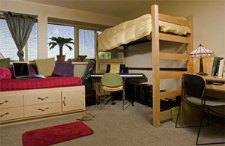By Cooper-John Trapp, Staff Writer
Several USM students report that residential students feel frustrated with the current housing waitlist of about 110 students. This means that when it came time for their lottery number to select housing there were no more rooms available. Christina Lowery, Director of Housing and Residential Life, says she and the housing staff hear student’s concerns.
The biggest and most immediate help, Lowery says, is residential housing on the Portland campus scheduled for completion in 2022.
Students facing the waitlist or a housing assignment said they feel “pretty upset,” according to Jon Thompson, a second-year residential student. Thompson says the day before his selection day arrived to pick housing, his top two choices, Upperclass Hall and Philippi Hall were full and left just Robie-Andrews Hall for him. He says “It’s ridiculous. I paid this school for two years and now my third year I’m paying to live in the second-oldest building on campus.”
Lowery says that a significant increase in desire for on-campus housing is driving the issue. More students want housing than before. One-hundred-and-forty more students requested housing this year than last, and 170 more last year compared to two years ago.
“That’s over 300 plus more students that want to live on campus,” Lowery says.
Over the two or three years, all possible extra spaces in the residence halls have been converted into bed spaces – classrooms, lounges, offices, etc. “Turning traditional double rooms into enhanced occupancy means that we can offer students a space,” explains Lowery.
A freshman student who wished to remain anonymous relayed their friend’s struggles with securing on-campus housing. They asked, “why not accept less students for housing?” Lowery says that to say no a student’s housing is to say no to their education. She offers an analogy: “think of your friend group. Which one(s) would you say no to?”
The university has explored several avenues to increase the number of beds for students on campus over the past three years. Last fall, the university sent requests for information to developers in the area about creating off-campus housing relationships. None were returned, Lowery says.
Another option they considered was modular housing that would cost $2-3 million dollars, but that option would not offer permanent spaces. “It’s a temporary money sink, unfortunately,” says Lowery.
Dickey-Wood, a two-tower dormitory closed due to living conditions and the presence of asbestos was ruled out due to the return of investment. To renovate Dickey-Wood, Lowery says, would cost $12-13 million. That would “only return the building to the condition it was in when it was closed,” and the timeline and future utility of that money spent just isn’t worth it, she says.
There is a feeling that the university does not care about housing its students, the freshman student reported.
“Housing is the university’s number one priority in executing the Master Plan,” and the bond monies secured last November, reports Lowery. Housing on the Portland campus is the first construction project the university is taking action on.
By 2022, Lowery says, residential living will offer 400 to 600 person capacity housing on the Portland campus. Portland housing is intended for law, graduate and upperclassmen students, to keep Gorham the location for new students to establish connections.
For students on the waitlist, Lowery reports that she believes all will get on-campus housing. Last year, the housing waitlist was resolved before fall. USM housing can be reached at: email [email protected]; phone: (207) 780-240; or in person at 125 Upton Hall Monday-Friday 8:00 a.m to 4:30 p.m.

